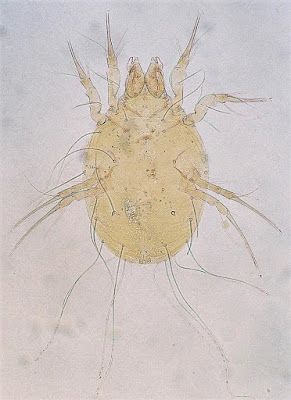Belongs within: Astigmatina.
The Glycyphagidae are a diverse group of mites mostly associated with the nests of small mammals, mostly characterised by the presence of a series of external ridges on the venter of the subcapitulum (OConnor 2009).
Characters (from OConnor 2009): Ventral subcapitulum with prominent pattern of external transverse and oblique ridges (ridges reduced in heavily sclerotised Fusacarus); palpi reflexed inwards; empodial claws small or absent; condylophores very thin or absent; female usually with epigynal apodeme and often with external copulatory tube, oviporus longitudinal with genital valves fused to body anteriorly, free posteriorly; male without paranal suckers or modified setae on tarsus IV. Deutonymph with attachment organ with setae p1–p2 in the form of ribbed claspers, or if absent, then vestiges of their alveoli present as small sclerotised rings (Baloghella), or attachment organ reduced and tibiae III–IV with large ventral, comblike setae; coxal setae 3a and 4a absent; posterior coxal apodemes with distinct edges.
<==Glycyphagidae [Glycyphagina] O09
|--Labidophorus P90 [Labidophorinae O09]
|--Marsupialichus [Marsupialichinae] O09
| `--M. johnstoni O09
|--Baloghella [Melesodectinae] O09
| `--B. melis [incl. Melesodectes auricularis] O09
|--Fusacarinae [Fusacaridae] O09
| |--Fusacarus O09
| `--Xenoryctes krameri O09, GHG91
|--Metalabidophorinae O09
| |--Metalabidophorus O09
| |--Paralabidophorus O09
| `--Neolabidophorus yucatanensis Pence & Genoways 1974 O09, QV01
|--Lophuromyopus [Lophuromyopodinae] O09
| `--L. schoutedeni O09
`--Glycyphagus Hering 1838 H98 [incl. Lepidoglyphus Zakhvatkin 1936 H98; Glycyphaginae O09]
|--G. destructor (Schrank 1781) W91 (see below for synonymy)
|--G. domesticus (de Geer 1778) [=Acarus domesticus, Glyciphagus (l. c.) domesticus] H98
|--G. hypudaei O09
|--G. latipes Berlese 1910 V25
|--G. ornatus (Kramer 1881) W91
`--G. spinipes P94
Glycyphagidae incertae sedis:
Dermacarus O09
|--D. hypudaei GHG91
|--D. ornatus Fain 1967 QV01
`--D. tamiasciuri O09
Prolepidoglyphus M-PV-G01
Gohieria Oudemans 1939 [incl. Ferminia Oudemans 1928 (preoc.)] H98
`--G. fusca (Oudemans 1902) [=Glycyphagus fuscus, Ferminia fuscus] H98
Zibethacarus P90
Ctenoglyphus Berlese 1884 [=Cthenoglyphus] H98
`--C. plumiger (Koch 1835) [=Acarus plumiger, Cthenoglyphus plumiger, Glycyphagus plumiger] H98
Orycteroxenus soricis O09
Dipodomyopus P90
Mediolabidophorus P90
Microlabidopus P90
Scalopacarus P90
Neoxenoryctes P90
Rodentopus sciuri O09, WK09
Grammolichus malukuensis O09
Pycnoglycyphagus O09
Lophioglyphus liciosus [incl. Apodemopus apodemi] O09
Diamesoglyphus intermedius O09
Cryptomyopus zachvatkini O09
Glycyphagus destructor (Schrank 1781) W91 [=Acarus destructor H98, Lepidoglyphus destructor W91; incl. A. cadaverum Schrank 1781 H98, G. cadaverum H98]
*Type species of generic name indicated
REFERENCES
[GHG91] Gállego, M., E. Hidalgo & J. Ginés. 1991. Mites of the house mouse, Mus musculus L., in the north-eastern part of the Iberian Peninsula in Spain. In: Schuster, R., & P. W. Murphy (eds) The Acari: Reproduction, development and life-history strategies pp. 453–454. Chapman & Hall: London.
[H98] Halliday, R. B. 1998. Mites of Australia: A checklist and bibliography. CSIRO Publishing: Collingwood.
[M-PV-G01 Montiel-Parra, G., G. A. Villegas-Guzman, M. Vargas & O. J. Polaco. 2001. Mites associated with nests of Neotoma albigula Hartley, 1894 (Rodentia: Muridae) in Durango, México. In: Halliday, R. B., D. E. Walter, H. C. Proctor, R. A. Norton & M. J. Colloff (eds) Acarology: Proceedings of the 10th International Congress pp. 586–593. CSIRO Publishing: Melbourne.
[O09] OConnor, B. M. 2009. Cohort Astigmatina. In: Krantz, G. W., & D. E. Walter (eds) A Manual of Acarology 3rd ed. pp. 565–657. Texas Tech University Press.
[P90] Philips, J. R. 1990. Acarina: Astigmata (Acaridida). In: Dindal, D. L. (ed.) Soil Biology Guide pp. 757–778. John Wiley & Sones: New York.
[P94] Pugh, P. J. A. 1994. Non-indigenous Acari of Antarctica and the sub-Antarctic islands. Zoological Journal of the Linnean Society 110: 207–217.
[QV01] Quintero, M. M. T., M. Vargas, B. S. Hernández, P García & N. J. Otero. 2001. Ectoparasitic mites on Heteromys gaumeri in the south of Yucatan, Mexico. In: Halliday, R. B., D. E. Walter, H. C. Proctor, R. A. Norton & M. J. Colloff (eds) Acarology: Proceedings of the 10th International Congress pp. 583–585. CSIRO Publishing: Melbourne.
[V25] Vitzthum, H. 1925. Fauna sumatrensis. (Beitrag no. 5). Acarinae. Supplementa Entomologica 11: 1–79.
[WK09] Walter, D. E., & G. W. Krantz. 2009. Oviposition and life stages. In: Krantz, G. W., & D. E. Walter (eds) A Manual of Acarology 3rd ed. pp. 57–63. Texas Tech University Press.
[W91] Walzl, M. G. 1991. Comparison of the sclerotized structures of Acaridae and Glycyphagidae used for copulation. In: Dusbábek, F., & V. Bukva (eds) Modern Acarology: Proceedings of the VIII International Congress of Acarology, held in České Budĕjovice, Czechoslovakia, 6–11 August 1990 vol. 2 pp. 283–286. SPB Academic Publishing: The Hague.

No comments:
Post a Comment
Markup Key:
- <b>bold</b> = bold
- <i>italic</i> = italic
- <a href="http://www.fieldofscience.com/">FoS</a> = FoS